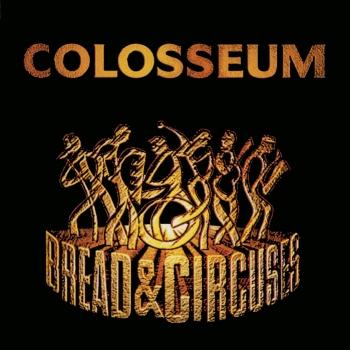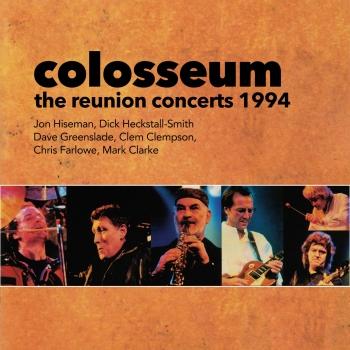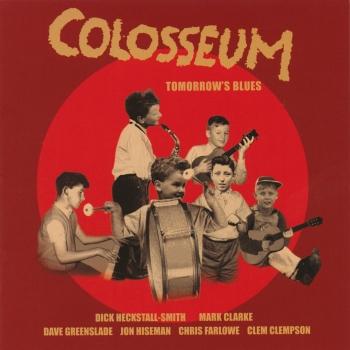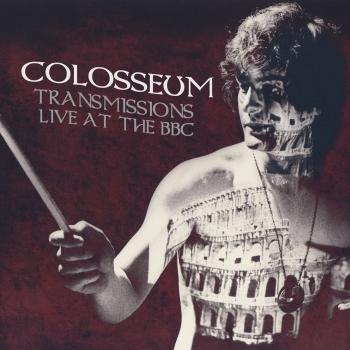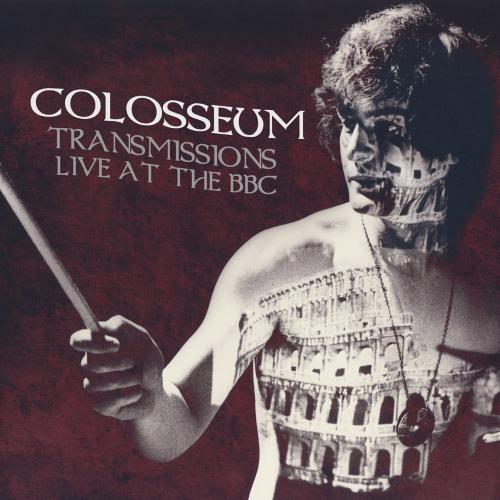
Transmissions Live at the BBC Colosseum
Album Info
Album Veröffentlichung:
2020
HRA-Veröffentlichung:
27.11.2020
Das Album enthält Albumcover
- 1 The Road She Walked Before (Live at the BBC Top Gear, 19 January 1969) 02:50
- 2 Backwater Blues (Live at the BBC Top Gear, 19 January 1969) 05:01
- 3 A Whiter Shade of Powell (Live at the BBC Top Gear, 19 January 1969) 02:46
- 4 Walking in the Park (Live at the BBC Symonds on Sunday, 16 March 1969 World Service Broadcast Version) 03:21
- 5 Interview with Jon Hiseman (Live at the BBC Symonds on Sunday, 16 March 1969 World Service Broadcast Version) 00:59
- 6 Beware the Ides of March (Live at the BBC Symonds on Sunday, 16 March 1969 World Service Broadcast Version) 04:06
- 7 Plenty Hard Luck (Live at the BBC Symonds on Sunday, 16 March 1969 World Service Broadcast Version) 02:38
- 8 Elegy (Live at the BBC Johnnie Walker, 24 May 1969) 03:01
- 9 Walking in the Park (Live at the BBC Johnnie Walker, 24 May 1969) 04:17
- 10 Butty's Blues (Live at the BBC Johnnie Walker, 24 May 1969) 05:57
- 11 I Can't Live Without You (Live at the BBC Johnnie Walker, 24 May 1969) 04:45
- 12 Elegy (Live at the BBC Top Gear, 6 July 1969) 02:48
- 13 The Grass is Greener (Live at the BBC Top Gear, 6 July 1969) 07:23
- 14 Hiseman's Condensed History of Mankind (Live at the BBC Top Gear, 6 July 1969) 02:28
- 15 February's Valentyne (Live at the BBC Top Gear, 6 July 1969) 06:16
- 16 Elegy (Live at the BBC Symonds on Sunday, 20 July 1969) 03:05
- 17 The Road She Walked Before (Live at the BBC Symonds on Sunday, 20 July 1969) 02:22
- 18 Walking in the Park (Live at the BBC Symonds on Sunday, 20 July 1969) 03:39
- 19 Butty's Blues (Live at the BBC Symonds on Sunday, 20 July 1969) 03:11
- 20 Elegy (Take 1) (Live at the BBC Radio 1 Jazz Workshop, 17 July 1969) 03:01
- 21 I Can't Live Without You (Live at the BBC Radio 1 Jazz Workshop, 17 July 1969) 04:45
- 22 Walking in the Park (Live at the BBC Radio 1 Jazz Workshop, 17 July 1969) 04:16
- 23 Those About to Die (Take 1) (Live at the BBC Radio 1 Jazz Workshop, 17 July 1969) 06:27
- 24 Butty's Blues (Take 1) (Live at the BBC Radio 1 Jazz Workshop, 17 July 1969) 06:50
- 25 Mandarin (Live at the BBC Radio 1 Jazz Workshop, 17 July 1969) 06:32
- 26 The Grass is Greener (Live at the BBC Radio 1 Jazz Workshop, 17 July 1969) 02:00
- 27 Interview with Dick Heckstall-Smith (Live at the BBC Top Gear, 22 November 1969) 01:40
- 28 Lost Angeles (Live at the BBC Top Gear, 22 November 1969) 08:45
- 29 Arthur's Moustache (Live at the BBC Top Gear, 22 November 1969) 06:25
- 30 Jumping off the Sun (Live Unknown Session Late 1969/Early 1970) 03:27
- 31 Theme for an Imaginary Western (Live Unknown Session Late 1969/Early 1970) 03:54
- 32 Take Me Back to Doomsday (Live Unknown Session Late 1969/Early 1970) 02:29
- 33 Lost Angeles (Partial) (Live Unknown Session Late 1969/Early 1970) 01:26
- 34 Angle (Live Unknown Session Late 1969 / Early 1970) 03:52
- 35 The Machine Demands a Sacrifice (Live Unknown Session Late 1969 / Early 1970) 02:42
- 36 Lost Angeles (Live at the BBC John Peel's Sunday Concert, 8 March 1970) 11:00
- 37 John Peel Introduction / Downhill and Shadows (Live at the BBC John Peel's Sunday Concert, 8 March 1970) 16:45
- 38 John Peel Introduction / Theme for an Imaginary Western (Live at the BBC John Peel's Sunday Concert, 8 March 1970) 06:19
- 39 John Peel Introduction / The Machine Demands a Sacrifice (Live at the BBC John Peel's Sunday Concert, 8 March 1970) 14:19
- 40 John Peel Introduction / Walking in the Park (Live at the BBC John Peel's Sunday Concert, 8 March 1970) 11:31
- 41 Bring out Your Dead (Live at the BBC Sounds of the 70s, 7 April 1970) 04:31
- 42 Time Lament (Live at the BBC Sounds of the 70s, 7 April 1970) 06:21
- 43 Daughter of Time (Live at the BBC Sounds of the 70s, 7 April 1970) 08:15
- 44 Rope Ladder to the Moon (Live at the BBC John Peel's Sunday Concert, 8 November 1970) 10:46
- 45 Downhill and Shadows (Live at the BBC John Peel's Sunday Concert, 8 November 1970) 13:34
- 46 Tanglewood '63 (Live at the BBC John Peel's Sunday Concert, 8 November 1970) 06:45
- 47 Time Lament (Live at the BBC John Peel's Sunday Concert, 8 November 1970) 07:22
- 48 Lost Angeles (Live at the BBC John Peel's Sunday Concert, 8 November 1970) 21:01
- 49 Butty's Blues (Live at the BBC Sounds of the 70s, 21 July 1970) 06:40
- 50 Shades of Blue (Live at the BBC Sounds of the 70s, 21 July 1970) 06:06
- 51 Rope Ladder to the Moon (Live at the BBC Sounds of the 70s, 21 July 1970) 03:45
- 52 Tanglewood '63 (Live at the BBC Sounds of the 70s, 21 July 1970) 06:16
- 53 Take Me Back to Doomsday (Live at the BBC Sounds of the 70s, 19 February 1971) 06:59
- 54 Skellington (Live at the BBC Sounds of the 70s, 19 February 1971) 12:21
- 55 The Pirate's Dream (Live at the BBC Sounds of the 70s, 19 February 1971) 11:58
- 56 Tanglewood '63 (Live at the BBC Sounds of the 70s, 19 February 1971) 11:19
- 57 Jumping off the Sun (Live at the BBC Sounds of the 70s, 10 September 1971) 05:31
- 58 Sleepwalker (Live at the BBC Sounds of the 70s, 10 September 1971) 07:01
- 59 The Pirate's Dream (Live at the BBC Sounds of the 70s, 10 September 1971) 12:51
- 60 Upon Tomorrow (Live at the BBC Sounds of the 70s, 10 September 1971) 07:49
- 61 Walking in the Park (Off Air) (Live at the BBC Symonds on Sunday, 16 March 1969 Off-Air) 03:46
- 62 Those About to Die (Take 2) (Live at the BBC Radio 1 Jazz Workshop, 17 July 1969) 06:36
- 63 Butty's Blues (Take 2) (Live at the BBC Radio 1 Jazz Workshop, 17 July 1969) 05:57
- 64 Elegy (Take 2 - Instrumental) (Live at the BBC Radio 1 Jazz Workshop, 17 July 1969) 04:50
Info zu Transmissions Live at the BBC
This is the BBC Radio 1 Service. We proudly present one of the world's greatest bands... Colosseum! Fans tuning into their wireless sets during the great age of progressive rock would have been thrilled to hear the announcer introduce one of their favourite bands about to hit the airwaves.
They wouldn't be disappointed. Few bands played with such power, fire and intensity whether in a club, at a festival or even in the confines of a radio station studio. Led by drumming legend Jon Hiseman, Colosseum was guaranteed to give an exciting performance as soon as the red recording light went on and the engineer gave the thumbs up.
Even so, it seemed like a fleeting moment, once the broadcasts were over, never to be heard again. But here is the exciting news. Many of the shows when Colosseum roared into epic arrangements like Walking In The Park, Daughter Of Time , Tanglewood 63 and Rope Ladder To The Moon were captured on tape for posterity, not only by the BBC but by listeners armed with their own home recorders.
So now it is Repertoire's turn to proudly announce the release of an amazing 6 albums set Transmissions - Live At The BBC featuring shows like John Peel's Top Gear and Sounds Of The 70s, and comprising some 60 tracks recorded between 1969 and 1971. We hear the earliest version of Colosseum with founder members Jon Hiseman, Dick Heckstall-Smith, Dave Greenslade and Tony Reeves joined by guitarist/vocalist James Litherland. Later classic line-ups include Dave Clempson on guitar with Chris Farlowe (vocals) and Mark Clarke (bass) with guest appearances by Barbara Thompson (sax/flute) and the New Jazz Orchestra.
This vast treasure trove of material has been rescued from the BBC and Colosseum archives, along with rare recordings by fans and enthusiasts. It has been painstaking collected, collated, restored and digitalised by the combined forces of historian and archivist Colin Harper, Jon's daughter Ana Gracey and Repertoire's own audio genius the mighty Eroc.
Colosseum
Digitally remastered
Colosseum
Der Name klingt bombastisch, und tatsächlich sind COLOSSEUM so etwas wie Saurier in der Geschichte der Rockmusik: ein Zusammenschluss von ungeheuer virtuosen Solisten,dabei trotzdem mit einem geschlossenen, kompakten Sound und in den verschiedenen Konstellationen musikalisch stets sehr innovativ. Die beiden ersten Alben, "Those Who
Are About To Die Salute You" und "Valentyne Suite", beide 1969, erreichten die Top 20 in den britischen Album-Charts. Gegründet wurde die Band 1968 von Schlagzeuger Jon Hiseman und dem Saxophonisten Dick Heckstall-Smith zusammen mit dem Organisten Dave Greenslade, dem Bassisten Tony Reeves und dem Gitarristen/Sänger James Litherland. Hiseman und Heckstall-Smith lernten sich 1967 in der GRAHAM BOND ORGANIZATION (mit Ginger Baker später Cream) kennen und stießen dann zu JOHN MAYALL´S BLUESBREAKERS (mit Mick Taylor später Stones), um die Studio-LP "Bare Wires" einzuspielen. Dieses erste COLOSSEUM line up war Teil des legendären Rock Movies SUPERSESSION mit Eric Clapton, Buddy Guy, Stephen Stills, Buddy Miles & Led Zeppelin.
Der eigentliche Kopf der Band war Schlagzeuger Hiseman - sein musikalischer Werdegang prägte auch die Stilvielfalt von COLOSSEUM: Er kam eigentlich vom Jazz, hatte aber auch Erfahrungen in Sachen Blues und Rock gesammelt und brannte darauf, komplexe musikalische Ideen mit einer Gruppe von handwerklichen Könnern umzusetzen. Was ihm auch gelang: Kritiker äußerten sich begeistert über das Plattendebüt, insbesondere über das Zusammenspiel raffinierter Bläsersätze mit der virtuosen, aber dabei ungeheuer kraftvollen Rhythmusmaschinerie. Beim Publikum kam zunächst das zweite Album ("Valentyne Suite", 1969) am besten an & COLOSSEUM schaffte es, sich einen Ruf als hervorragender und innovativer Live-Act aufzubauen. Anfang 1970 ging Litherland zu MILLION und Reeves zog sich wieder auf seinen Posten als Produzent zurück, diesmal für Sandy Denny und John Martyn. Hiseman ersetzte sie durch den früheren BAKERLOO-Gitarristen Dave 'Clem' Clempson, den Bassisten Mark Clarke und verpflichtete einen professionellen Sänger: Chris Farlowe. Farlowe galt als prominenter Vertreter der britischen Rhythm'n'Blues-Szene & hatte schon 1966 einen Nummer-Eins-Hit mit dem ROLLING STONES-Song "Out Of Time".
In dieser Besetzung, verstärkt durch Barbara Thompson, Hisemans Lebensgefährtin und hervorragende Jazz-Saxophonistin, nahmen COLOSSEUM 1970 die dritte LP, "Daughter of Time" auf - es sollte die letzte Studio-LP werden. Denn ein knappes Jahr später, im Oktober/November 1971 ließ sich diese Band von Solo-Virtuosen nicht länger zusammenhalten. Clempson ging als Nachfolger von Peter Frampton zu HUMBLE PIE; Farlowe widmete sich - nach einem Zwischenspiel bei ATOMIC ROOSTER - weiter seiner Solokarriere; Greenslade gründete eine Band unter eigenem Namen & Heckstall-Smith zog ebenfalls eine eigene Band auf. Clarke und Hiseman gründeten mit Sänger Paul Williams (Ex-Zoot-Money-Band) und Gitarrist Allan Holdsworth, der später zu SOFT MACHINE gehen sollte, TEMPEST.
Praktisch gleichzeitig mit dem Split der Band kam allerdings noch ein Doppelalbum auf den Markt, das man sicherlich auch heute noch getrost als ein Juwel der Rockgeschichte bezeichnen kann: "Colosseum Live"
Zusammengestellt wurde es aus Aufnahmen von zwei Konzerten vom März 1971 in Brighton bzw. Manchester. Die sechs Stammusiker von "Daughter Of Time" sind in Höchstform zu hören: "Lost Angeles" und "Skelington", die jeweils eine Plattenseite füllen, sowie die Zugabe eines der Konzerte, der "Stormy Monday Blues", gehören als Klassiker der Rockmusik eigentlich in jeden Plattenschrank - es gibt kaum andere Aufnahmen aus der damaligen Zeit, die anschaulicher die wechselweise sich befruchtende Spielfreude virtuoser Solisten in einem komplexen Gruppenzusammenhang dokumentieren. Hiseman brachte Anfang 1972 noch eine authorisierte Best-Of-Zusammenstellung heraus ("Collector's Colosseum") und widmete sich dann seiner neuen Band, TEMPEST. 1975 versuchte er mit COLOSSEUM II den alten Geist wiederzubeleben: Zum Line-Up gehörten diesmal der ehemalige SKID ROW- und THIN LIZZY- Gitarrist Gary Moore, Sänger Mike Starrs, Keyboarder Don Airey und Bassist Neil Murray. In dieser Besetzung spielte man 1976 "Strange New Flesh" ein, ein Album das trotz der stärkeren Hardrock-Einflüsse, die vor allen Dingen von Moores Kompositionen in die Band gebracht wurden, immer noch dem alten COLOSSEUM-Sound relativ nahe kommt. Ende '76 ging Starrs zu LUCIFER'S FRIEND und Murray wurde von John Mole ersetzt. 1977 kamen noch zwei Alben, "Electric Savage" und "Wardance", beide rocklastig, aber jazzbeeinflusst auf den Markt. 1978 ging Moore zu THIN LIZZY zurück, für ihn kam Aireys Bruder Keith; Ende des Jahres, als Don Airey mit Richie Blackmore von DEEP PURPLE RAINBOW aufmachte, war es mit COLOSSEUM II endgültig vorbei. Hiseman gründete mit seiner Frau Barbara Thompson bereits 1975 das UNITED JAZZ AND ROCK ORCHESTRA, in ihrer Jazzformation PARAPHERNALIA spielt er seit 1979. Beide arbeiteten außerdem auch noch mit Leuten wie Johnny Dankworth und Andrew Lloyd Webber zusammen.
1994 reformierte sich die Formation in der ´klassischen´ "Colosseum Live"- Besetzung von 1971 und präsentierte seither ihr Programm mit großem Erfolg auf zahlreichen Festivals und Europa-Tourneen, flankiert durch ihre Veröffentlichungen "The Reunion Concerts 1994", "Bread And Circusses" (1997), "Tomorrows Blues" (2003) & "LIVE ´05" (2007). Für den im Dezember 2004 verstorbenen Saxophonisten Dick Heckstall-Smith spielt Barbara Thompson das Saxophon. (Quelle: MUNZINGER ARCHIV)
Dieses Album enthält kein Booklet









